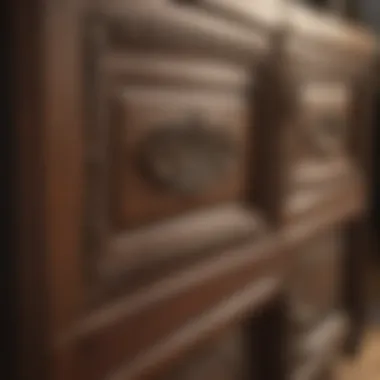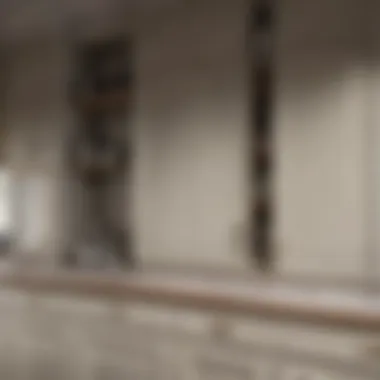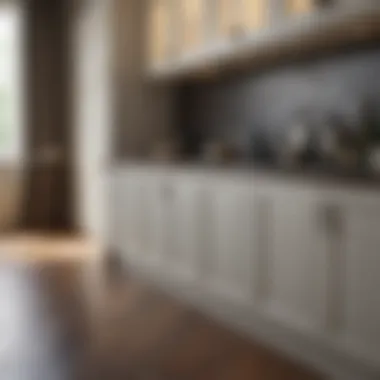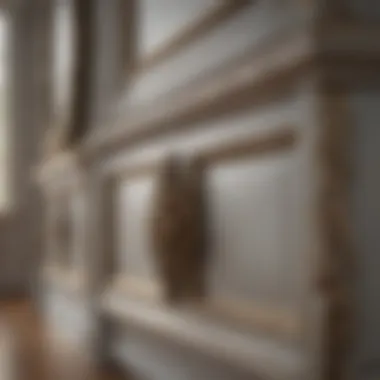Expert Techniques for Painting Cabinets


Intro
Painting cabinets is a practical and effective way to refresh your home. It allows homeowners to change the color and finish of their cabinets without investing in new ones. This process not only enhances the aesthetic appeal of the cabinetry but also increases the overall value of a home. More importantly, knowing how to do it correctly can save significant money compared to hiring a professional.
The home improvement industry often emphasizes the transformative power of a fresh coat of paint. Surprisingly, many homeowners underestimate the importance of technique and preparation. Poor techniques can result in finishes that quickly chip and peel, leading to frustration and wasted effort.
In this article, we will delve into the best methods for painting cabinets. We will cover all necessary aspects, from preparation to finishing. By addressing common challenges, discussing product recommendations, and providing a step-by-step guide, our aim is to equip our readers with a useful guide for achieving a professional look in their cabinet painting projects.
Common Challenges and Solutions
Many homeowners encounter specific challenges when painting cabinets. Understanding these hurdles can help them achieve a smoother workflow.
- Time Consumption: One of the most significant issues is underestimating the time required for proper preparation and painting. Often, people think it’s a simple task that can be completed in a single day, leading to rushed and poor results.
- Inadequate Preparation: Failing to adequately clean and sand the surfaces can lead to paint adhesion problems. This step cannot be skipped.
- Paint Selection Confusion: With so many types of paint available, choosing the right one can be overwhelming. Oil-based, latex, or chalk paints all have specific benefits, yet their application varies.
Solutions:
- Planning: Allocate sufficient time for each stage of the project. A well-structured schedule will alleviate stress.
- Preparation: Clean thoroughly and sand surfaces to ensure proper paint adherence. Moreover, using a primer can vastly improve final results.
- Consultation: Engage in online forums like Reddit to discuss experiences and recommendations about particular paint types.
Product Recommendations
When embarking on cabinet painting, choosing the right products is crucial. Various brands dominate the market with strong reputations for quality.
- Benjamin Moore Advance: This paint offers excellent leveling and finishes smoothly. It is a top pick for those looking for a durable finish.
- Rust-Oleum Chalked Paint: Ideal for achieving a vintage finish. Its application is straightforward and forgiving for beginners.
- Sherwin-Williams ProClassic: This product is another great choice for a smooth, professional appearance. Its formulation is designed for durability and easy cleaning.
- Benefits: Quick drying time, low VOC, easy to clean.
- Features: Adheres well without extensive sanding and provides a matte finish.
- Benefits: Exceptional color retention and durability against wear and tear.
Step-by-Step Guides
Adhering to a structured step-by-step guide simplifies the painting process. Here is a practical outline to follow:
- Preparation:
- Priming:
- Painting:
- Finishing Touches:
- Remove cabinet doors and hardware.
- Clean all surfaces thoroughly using a degreaser.
- Sand all surfaces lightly to improve adhesion.
- Apply a high-quality primer suited for the selected paint type. Use a brush or roller for even coverage.
- Allow the primer to dry according to the manufacturer’s instructions.
- Choose your paint and apply it smoothly using a brush for details and a roller for larger areas. Avoid overloading the tools to prevent drips.
- Apply two to three coats, allowing proper drying time between applications.
- Once fully dry, reattach the cabinet doors and hardware. Ensure everything lines up correctly for optimal functionality.
- For added protection, consider using a clear coat sealant over the paint for extra durability.
With proper execution of these steps, you can enjoy beautifully updated cabinets that stand the test of time.
Understanding Cabinet Painting
Cabinet painting can drastically transform the aesthetic of a space without incurring the costs associated with new cabinetry. This process involves selecting the right materials, tools, and techniques, ensuring that the outcome meets both functional and aesthetic criteria.
Proper understanding of cabinet painting is essential for both novices and experienced DIY enthusiasts. When you grasp the core principles, you enhance your ability to make informed decisions throughout the project.
There are several critical elements to consider:
- Durability: Painted cabinets endure daily wear and tear. Knowing which materials and methods yield a lasting finish is paramount.
- Aesthetics: The visual impact of painted cabinets can elevate the overall charm of your home. Color choice and finish affect light reflection and visual perception.
- Economics: Opting to repaint instead of replacing cabinetry is cost-effective. Understanding how to maximize your budget can lead to impressive results.
The benefits of acquiring knowledge in cabinet painting extend beyond successful projects. Homeowners who engage in this practice often report a sense of pride in their finished work. This satisfaction does not only stem from visual appeal but also from the DIY journey itself. When armed with the proper preparation and techniques, anyone can attain results akin to professional craftsmanship.
Preparing adequately for this undertaking ensures smooth execution, reduces mistakes, and ultimately leads to a desirable outcome. Knowing what to expect and addressing potential issues before they arise contributes significantly to the success of cabinet painting.


The Importance of Preparation
Preparation forms the backbone of successful cabinet painting. It is often the part that can make or break your project. Without proper preparation, the final appearance and durability of the paint can be compromised.
Essential preparatory steps include:
- Cleaning: This is vital to remove grease and dirt. A clean surface allows paint to adhere correctly.
- Sanding: This process helps to create a surface that promotes better grip for the paint.
- Priming: Priming prepares the surface and enhances paint adhesion while also providing a uniform base color.
Each of these steps cannot be overlooked. Neglecting any aspect of preparation can lead to peeling paint or uneven finishes down the line. A well-prepared canvas promises a smoother painting experience.
Evaluating Your Cabinets
Before commencing any painting project, it is important to evaluate the current state of your cabinets. This assessment aids in formulating an effective plan and can determine whether minor repairs or significant overhaul is necessary.
Key factors to consider during evaluation are:
- Material Composition: Identifying whether your cabinets are made from wood, laminate, or another material will guide your choice of paint and preparation techniques.
- Condition: Check for any damage like scratches, dents, or water stains. These must be addressed before painting to ensure a smooth finish.
- Style: Understanding your cabinet style informs the color and finish choices that will best match your home’s aesthetics.
Evaluating your cabinets prior to the painting process lays the groundwork for making decisions about technique and materials, thus setting the stage for a successful cabinet transformation.
Choosing the Right Materials
Choosing the right materials is a foundational step in cabinet painting. This decision directly affects not only the aesthetics but also the durability and longevity of your finishes. The quality and type of paint, as well as the tools used in the process, can make the difference between a job that looks professional and one that appears poorly executed. Proper selection of materials contributes to ease of application, the overall finish quality, and the longevity of the paint job.
When selecting materials, consider your cabinets' existing condition, the intended use of the cabinets, and your personal style preferences. Different paints and application tools interact differently with surface textures and cabinet designs. Understanding these interactions can help ensure a proper finish.
Types of Paint
Types of finishes
The finish of the paint you choose has a significant impact on how light interacts with your cabinets, thus influencing their appearance. Common choices of finishes include matte, satin, semi-gloss, and high-gloss. Each provides a distinct look and feel; for instance, semi-gloss reflects more light than a matte finish, providing a cleaner look that is often popular in kitchens.
A matte finish can hide imperfections but may be less durable, while a high-gloss finish highlights details but requires meticulous preparation and application to avoid uneven patches.
Water-based vs. oil-based
This choice is critical as it affects drying times and ease of application. Water-based paints are generally easier to clean up, have lower levels of VOCs (volatile organic compounds), and dry faster. They are particularly beneficial when working in enclosed spaces or where fumes could be an issue.
On the other hand, oil-based paints can provide a more durable finish that withstands wear better, which may be important in high-traffic areas. However, they have longer drying times and require stronger solvents for cleanup.
Latex vs. acrylic
In the realm of water-based options, latex and acrylic paints are both popular but serve slightly different purposes. Latex paint is generally easier to apply and dries quickly. It works well on many surfaces and is less likely to yellow over time. Acrylic paint, however, offers superior adhesion and flexibility. It might be more suitable for kitchen cabinets that experience frequent temperature changes. Each type has its pros and cons, making it crucial to assess your specific needs when making a selection.
Essential Tools
Brushes and rollers
The choice of brushes and rollers can significantly influence the overall finish of your cabinets. Brushes can provide precision in corners and edges, while rollers are excellent for covering large flat areas quickly. Choosing high-quality tools can prevent bristle loss and uneven painting, ensuring a smoother finish. Rollers with a tight nap are generally preferred for flat surfaces, while those with a longer nap work better on texturized surfaces.
Sprayers
Sprayers are ideal for achieving an even coverage on intricately designed cabinets. They can save time and effort, especially for large projects. However, they require proper safety measures and methods to control overspray, ensuring that surrounding areas remain untouched. Additionally, practice may be required for those unfamiliar with sprayers.
Sandpaper and scrapers
Proper surface preparation is essential for any paint project. Sandpaper and scrapers help to remove old finishes and create a smooth surface for new paint. They eliminate peeling areas and enhance paint adhesion. A selection of grits, from coarse to fine, will typically be needed to achieve the desired smoothness before painting.
"Preparation can be the difference between a beautifully painted surface and one that requires redoing soon after it is finished."
In summary, carefully selecting paint types and essential tools is crucial for successful cabinet painting. This choice influences not only the appearance of the cabinets but also the experience and ease of the painting process.


Preparation Process
Preparation is a critical step in the cabinet painting journey. It lays the foundation for achieving a smooth finish and ensuring that the paint adheres well to the surfaces. Neglecting proper preparation can lead to peeling, chipping, or an uneven finish, ultimately compromising the visual appeal of your cabinets. Therefore, understanding and executing each part of the preparation process is paramount.
Cleaning the Cabinets
The first step in preparing your cabinets for a fresh coat of paint is thorough cleaning. This process is more than just a quick wipe-down. Grease, dirt, and grime can interfere with paint adhesion. Use a mixture of warm water and mild detergent. A sponge or soft cloth works well to remove existing residue. Pay special attention to areas around handles or seams where dirt accumulates. If the cabinets have a significant build-up of grease, consider using a degreaser specifically designed for kitchen surfaces.
After cleaning, rinse the cabinets with clear water to remove any soap residue. Dry them with soft towels to ensure no moisture remains.
Sanding and Priming
Once the cabinets are clean and dry, the next step is sanding. This process is essential for creating a rough surface that promotes paint adhesion. Use medium-grit sandpaper to sand down the existing finish. Ensure you sand in the direction of the wood grain to prevent damage. After sanding, remove dust using a vacuum or a damp cloth.
Priming is equally important. A quality primer will help to block stains and serve as a base for the paint. Choose a primer formulated for the type of paint you plan to use, whether it's water-based or oil-based. Apply the primer using a brush or roller, being careful to cover all surfaces evenly. Allow the primer to dry fully before proceeding to paint. Priming can significantly affect the final outcome, making it vital not to skip this step.
Removing Hardware
Before you apply paint, remove all hardware from the cabinets. This includes knobs, hinges, and any other fixtures. Doing so allows for easier access to all surfaces and avoids any unsightly paint over-spray on the hardware. Store the removed hardware in labeled bags to prevent loss, and consider cleaning them as well. It can be refreshing to reinstall clean hardware on newly painted cabinets.
In sum, completing the preparation process with attention to detail not only enhances the application of paint but also greatly contributes to the longevity and overall aesthetic of your cabinets.
Painting Techniques
Understanding proper painting techniques is crucial in achieving a professional look when painting cabinets. The technique employed can significantly influence the final outcome, ensuring durability and an aesthetically pleasing finish. Homeowners should take the time to learn about various application methods, including brush application, roller techniques, and spraying cabinets. Each has its unique advantages and considerations, which can yield different results depending on the desired finish and the specifics of the cabinet's surface.
Brush Application
Using a brush can provide a certain level of control and precision. It is often ideal for detailed work, such as edges and corners that require attention. However, it is important to consider some key aspects.
Best practices for brushes
Selecting the right brush is crucial to achieving the best results. Synthetic bristle brushes are often recommended for water-based paints, while natural bristle brushes work better with oil-based paints. The best practice is to choose a high-quality brush for a professional finish. Quality brushes minimize brush strokes and improve paint application on the surface.
Additionally, cleaning the brush before starting and during the painting process helps maintain its condition and performance. A well-maintained brush can last a long time, making it a wise investment.
Achieving even coverage
Even coverage is essential for a flawless finish. This technique involves applying a consistent layer of paint across the cabinet surface without leaving missed spots or heavy areas. It is achieved by using smooth, even strokes and overlapping each stroke slightly.
One must keep in mind the speed of application. Too slow may lead to drips, while applying too fast can cause uneven layers. Thus, maintaining a steady pace is vital for optimal outcomes.
Roller Technique
Rollers are generally favored for their ability to cover large areas quickly. They can help reduce the time spent painting, which is beneficial for DIY enthusiasts.
Choosing the right roller
Selecting an appropriate roller is essential for a smooth application. Foam rollers are great for achieving a glass-like finish. However, for those who prefer a textured surface, a fabric roller may provide the best results. The choice of roller nap thickness will also influence the finish; a shorter nap gives a smoother result.
Choosing a roller that matches the paint type is also important. A roller specifically designed for the paint allows for better absorption and transfer to the surface, resulting in an even application.
Tips for smooth application
To ensure a smooth application when using a roller, loading the roller correctly is important. Dipping the roller in paint and rolling it on a tray can help achieve the right amount of paint. Applying paint in a W or M pattern can distribute the paint evenly, which helps eliminate the risk of streaks.
Moreover, using a light hand when rolling can avoid pushing too much paint into the surface and causing texture issues.
Spraying Cabinets
Spraying is a technique that produces a uniform finish, making it popular among professional painters. It can be quite effective for large areas as well, although it requires more preparation time.


Equipment needed
To spray cabinets, one will need a high-quality paint sprayer. Options include airless sprayers or HVLP (high volume low pressure) sprayers. Each has its benefits, with airless sprayers covering large areas quickly, and HVLP sprayers providing fine finishes.
Proper setup is crucial. This includes using a spray booth or a well-ventilated area to avoid overspray and protect surrounding surfaces. Utilizing appropriate masks and goggles prevents inhalation of fumes.
Safety precautions
Safety must always be a top priority when spraying paint. Wearing a respirator is critical to avoid inhaling harmful vapors. Likewise, using gloves and goggles protects from direct contact with paint and spray.
Ensuring the work area is adequately ventilated will help in reducing fumes. Properly covering nearby objects and surfaces will minimize cleanup should any overspray occur.
"Investing time in learning various painting techniques can prove vital to the overall success of your cabinet painting project."
By careful selection of the painting technique and related tools, anyone can achieve impressive results. Recognizing the strengths and weaknesses of each method empowers homeowners to make informed choices, leading to satisfying outcomes.
Ensuring a Professional Finish
Achieving a professional finish when painting cabinets is crucial for both aesthetics and durability. Homeowners often seek that refined look, which elevates the overall appeal of their spaces. A successful finish not only enhances appearance but also safeguards against wear and tear, ensuring the investment lasts longer.
Several elements contribute to a professional finish. Among them, careful surface preparation, the right paint application techniques, and attention to detail stand out. These factors determine how smooth and even the final coat appears. For instance, even minor imperfections can be magnified after completion, leading to disappointment. Therefore, adhering to best practices is essential to reach desired outcomes and maintain satisfaction long after the task is done.
The benefits of focusing on a professional finish are manifold. It fosters an impression of quality in one’s home, increasing property value and appeal. Moreover, a well-finished cabinet surface is easier to clean and can withstand daily use better than a hastily done job. Ignoring the details may save time initially but often leads to recurrent issues which could have been avoided.
"A great finish reflects not just skill but also the thoughtfulness put into each step of the process."
In summary, ensuring a professional finish should be at the forefront of any cabinet painting endeavor. By acknowledging its importance and incorporating effective techniques, homeowners can transcend the ordinary and embrace standout results.
Tips for Smooth Paint Finish
To achieve a smooth paint finish, several tips should be observed throughout the painting process:
- Select the right paint: High-quality paints often provide better leveling and durability.
- Use suitable tools: A combination of brushes and rollers, appropriate for the width of the surface, is vital.
- Create a dust-free environment: Ensure the workspace is clean before beginning. Dust particles can settle on the wet paint, creating an uneven surface.
- Thin coats matter: Applying multiple thin coats rather than one thick layer helps prevent runs and promotes smoothness. Allow adequate drying time between coats.
- Practice on a sample: Testing techniques on a scrap piece of cabinet wood can reveal issues before addressing the actual cabinets.
Implementing these tips can significantly improve the final appearance of the painted cabinets, leading to a professional-looking finish.
Dealing with Runs and Drips
Despite best efforts, runs and drips can happen during the painting process. Knowing how to address these issues is essential for maintaining a polished look. Several strategies can mitigate or correct these imperfections:
- Immediate action: If you notice runs while the paint is still wet, lightly smoothing it with a brush or roller can help. Be gentle to avoid removing too much paint.
- Sand once dry: Allow the paint to dry fully, then lightly sand the area using fine-grit sandpaper. This prepares the surface for additional coats without compromising the overall finish.
- Touch-up as necessary: After sanding, repaint the area with a fine brush, matching the original color. This technique helps integrate the touch-up seamlessly into the surrounding surface.
- Prevent future problems: Ensure your applications are even, and avoid overloading the brush or roller with paint. Also, maintain a steady hand and consistent motion throughout the process to minimize the chance of runs.
By applying these methods for handling runs and drips, you safeguard the continuity of the painted surface and uphold the professional quality of your cabinets.
Post-Painting Care
Post-painting care is critical in ensuring that the newly painted cabinets maintain their fresh look and durability. After investing time and effort into a cabinet painting project, taking the necessary steps for proper post-painting care can enhance longevity and appearance. This part of the process includes waiting for the paint to cure, reattaching hardware, and ongoing maintenance. Each of these aspects plays a role in preserving the work done and the aesthetic appeal of the cabinets.
Curing Time and Patience
Curing time refers to the period needed for the paint to fully harden and adhere to the surface. This period can vary based on the type of paint used, environmental conditions, and the thickness of the paint application. Typically, water-based paints can take about two weeks to cure fully, while oil-based paints may extend to longer periods. It is crucial to avoid regular usage of the cabinets during this time to prevent any potential damage.
Patience is a significant component here. It might be tempting to use the cabinets immediately after the paint appears dry, but doing so can result in fingerprints, smudges, or even scratches. Emphasizing the importance of proper curing time can avoid future regrets and maintain the professional finish achieved through careful work.
Reinstalling Hardware
Once the cabinets have cured, the next step is reinstalling hardware. This can include handles, knobs, and hinges that were removed before painting. When reattaching hardware, one should ensure that the position is aligned correctly to avoid misalignment, which can lead to aesthetic inconsistency. Also, one should consider using new hardware for a more updated look. When reinstalling the original hardware, inspect it for any signs of wear. If necessary, refinishing or replacing old knobs and pulls can significantly enhance the overall look of the cabinets and create a polished appearance.
Maintaining Your Cabinets
Keeping cabinets in optimal condition means committing to regular maintenance. The upkeep includes cleaning, checking for wear and tear, and making necessary adjustments.
- Cleaning: Use mild soap and water on a soft cloth to clean surfaces regularly. Avoid abrasive cleaners that may scratch the paint.
- Inspecting: Every so often, check for discrepancies in the finish, such as chips or scratches. Taking quick action on these will help in preventing larger repair needs in the future.
- Adjusting: Sometimes, hinges and hardware may become loose over time. Ensuring they are snug can prevent further damages.
Regular maintenance not only keeps the cabinets looking fresh but also contributes to their lifespan.
Taking care of your cabinets post-painting enhances both their integrity and appearance, ensuring that the effort put into the painting process pays off well into the future.







